- Published 12 Jan 2023
- Last Modified 9 Aug 2023
- 9 min
A Complete Guide to First Aid Kits
Discover everything you need to know about first aid kits for the workplace in our comprehensive guide.

Reviewed by Jay Proctor, Technical Support Engineer (December 2020)
What is a First Aid Kit?
A first aid kit contains a range of supplies used to provide medical treatment. They are kept in environments including homes, schools, vehicles, and businesses.
These kits are designed with the first response in mind. They allow those in need to quickly be given medical assistance. They are mostly used for treating minor injuries like cuts, wounds and abrasions. However, they can also help with critical injury while waiting for emergency services to arrive.
It is highly beneficial to maintain well-organised kits, as this provides fast access to what is needed. It is also essential to consider where they are kept to ensure that they are easily visible and accessible to everyone.
Cases can be stored on worktops, in cabinets, or mounted to walls. It is worth bearing in mind that wall-mounted types can make it more challenging to transport required items as compared to an easily moveable portable case.
The importance of first aid kits should not be overlooked. It is vital to have a first aid kit in the workplace, to ensure compliance with the Health and Safety (First Aid) Regulations 1981. Per these regulations, employers must enable the provision of suitable personnel, facilities, and equipment to make sure that immediate attention can be provided if employees are taken ill or sustain an injury at work. They are applicable for all workplaces, including those with under five employees and anyone self-employed.
Contents of First Aid Kits Checklist
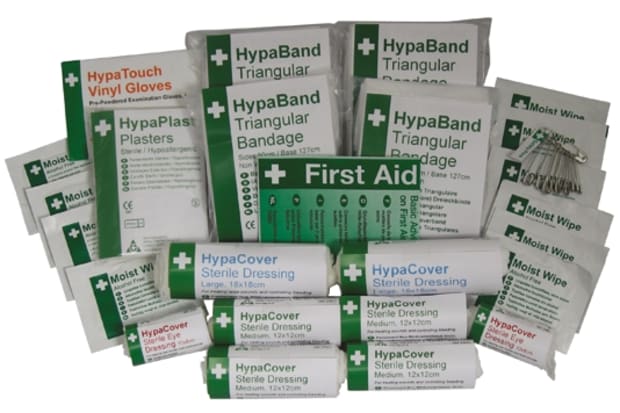
There is no mandatory list of items for a first aid kit but there are key staples which should form the basis of most standard boxes. Understanding what to have in a first aid kit will depend on several factors such as common risks, the size of the kit, and whether it is specialised or simply needs to contain the core first aid kit essentials.
First aid kit refills can also be purchased to restock used or expired items. Refills are important as a well-stocked case is vital in the event of injury. It is advisable to create a checklist of essentials and ensure that aid supplies are regularly monitored.
While the exact products can vary, the following list for first aid kit contents shows the basic items which should be included:
- Plasters - in a range of shapes and sizes, including washproof ones
- Sterile dressings and gauze pads - ideally a variety of small, medium and large sections
- Creams and sprays - for antiseptic purposes as well as treating conditions such as skin rashes, insect bites and stings
- Eyewash solution, eye bath, and eye pads - these are used to flush dust, sand, and debris from the eye
- Alcohol-free cleansing wipes
- Safety pins
- Disposable gloves - typically nitrile gloves as these gloves are sterile and efficient
- Tweezers
- Scissors
- Crepe rolled bandages - usually elastic, these are used to apply pressure, secure dressings, provide support, and reduce swelling
- Adhesive tape or micropore tape
- A thermometer
- Triangular bandages - these are rigid and are generally used for slings, securing splints, and restricting movement where necessary
- Adhesive dressings - these are small strips of gauze attached to an adhesive backing. They are used for minor cuts and injuries to the skin
- Non-adhesive dressings - these are intended for covering burned or grazed skin as it is important not to use adhesive bandages on fragile skin
- Wound dressings - these are thick pads which help to control bleeding and minimise the risk of infection
- A first aid booklet and a leaflet containing important safety guidelines and treatment information
Different Types of First Aid Kits
Various types of first aid kits are available, each best suited to different applications, environments, and potential injuries. Common examples include food compatible catering first aid kits, specialised burns kits, and industrial first aid kits.
It is possible to group a first aid kit by its size and the number of patients its products can treat. For instance, 50+ person kits are likely to be much more suitable to larger or more crowded spaces. Conversely, a large workplace first aid kit may not be necessary for offices with only a few employees, for example.
Some of the main types are explored in further detail below:

Carrying Case
These can be easily carried to the location of the casualty and are available in either fabric pouches or durable plastic boxes.
Some of these types can also be wall-mounted.
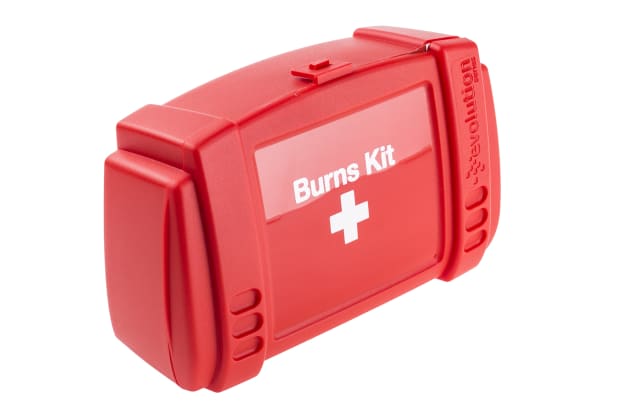
Burns Kit
These contain everything needed to treat burn injuries – both for easing pain as well as minimising the risk of scarring.
They contain additional items to sterilise areas of burned skin, specialised burn dressings, and gel to calm skin and help it heal.
Specialist kits such as this are ideal for commercial kitchen environments.
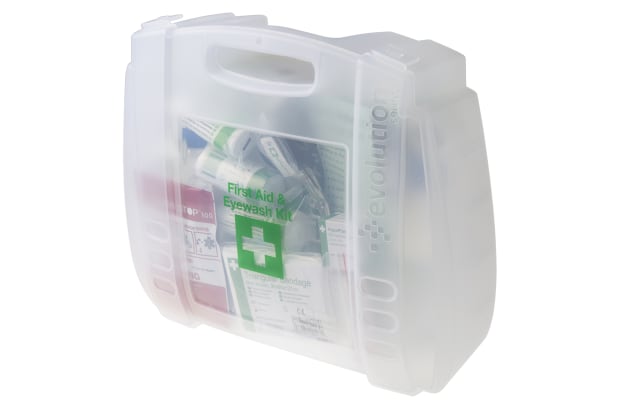
Eyewash Kit
These feature sterile wash for eyes, alongside other medical supplies.
They are ideal for use in schools, environments which use lots of chemicals, or applications such as carpentry, metal or glass working.
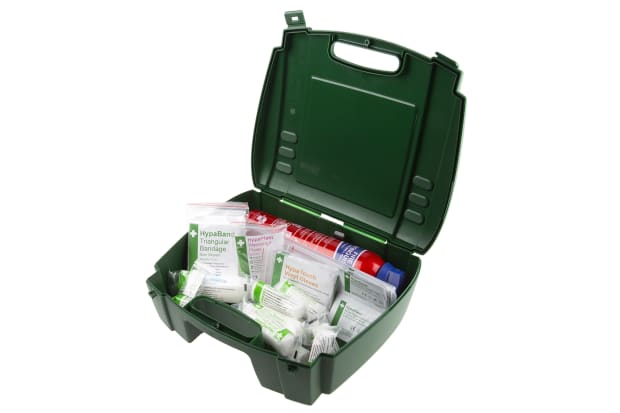
First Aid and Fire Extinguisher Kit
These packs are Health and Safety Executive (HSE) compliant, with first aid and fire protection conveniently stored together.
As well as medical supplies, they include a factory-sealed fire extinguisher for eliminating liquid and electrical fires.
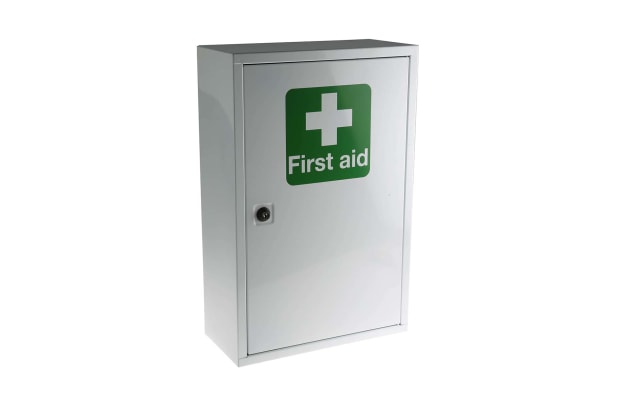
Wall-Mounted
These types have the benefit of being more visible and accessible for a wider number of people. Typically marked with a large white cross, they are designed for quick and easy identification.
This helps to raise awareness of where they are located, which can help to save time in emergency situations.
However, it is important to bear in mind that wall-mounted boxes can make it more challenging to transport the required products to the scene of an emergency.
First Aid Kit Requirements
The importance of first aid should not be underestimated. Employers are required to complete a risk assessment and a first aid needs assessment, meaning the contents of a particular kit might vary due to specific workplace requirements. The BS 8599-1 standard (June 2011) specification can assist employers and managers with understanding which type is necessary.
The BS 8599-1 standard also provides first aid kit guidelines regarding the container which holds the supplies. A compliant workplace first aid kit should be able to fit all the relevant items inside and close securely, as well as be clean, dustproof, and provide protection in the relevant environment.
First Aid Kits for the Workplace
The importance of first aid kits in the workplace should not be overlooked. Work first aid kits should be readily available and easily accessible whenever emergencies occur. The most suitable location will depend on the environment and the type of work being done.
You may consider keeping the business' first aid kits in a dedicated area, where they can be quickly accessed. For anyone who drives company vehicles or works out in the field on different sites, workplace kits will need to be taken along in the car. The location, occupation, and potential hazards may also impact what should be in a first aid kit at work. For further information, view our helpful guide on first aid in the workplace.
First aid supplies come in assorted sizes. The size of the box or case will impact the number of supplies contained and the number of employees they can serve. It is also important to consider the level of risk associated with the environment and the tasks being carried out. Here is a guide on which size to use for the number of people:
Low-Risk Environment
This includes low-hazard premises such as offices, schools, and retail.
- Small - less than 25 people
- Medium - 25 to 100 people
- Large - more than 100 people
High-Risk Environment
High-risk environments are areas such as warehouses and production lines, as well as businesses which require employees to work with dangerous machinery or sharp instruments.
- Small - less than 5 people
- Medium - 5 to 25 people
- Large - more than 25 people
When choosing a workplace first aid kit, you should consider these factors:
- The number of employees on the premises, ensuring there are enough supplies for each person
- The amount, size, and complexity of floors at the building or site. It is important to have at least one bag on every floor where employees are working. Where floors are large, multiple kits should be made available
- The level of risk. For example, an office is generally considered to be lower risk than a factory, so this will impact the amount of first aid equipment required
Top Tip!
Ensure that the supplies being used comply with the British Standard BS 8599-1. This guarantees the kit has suitable equipment which is safe and hygienic.
FAQs
What are First Aid Kits Used for?
These kits contain valuable supplies which can be used to treat minor injuries in the event of accidents or emergencies. These are essential pieces of equipment and should be readily accessible in all workplaces. These kits are typically suitable for treating injuries such as minor cuts, scrapes, stings, and burns.
What Should Not Be in a First Aid Kit?
A first aid box should contain a range of important supplies - but not medication. These are not considered to be first aid items and as such, they should not be included on your checklist. This includes common medications such as ibuprofen and antihistamines. Typically, consumables are not included both for this reason and also due to the risk of allergic reactions.
How to Store First Aid Kits?
To properly store and take care of a medical kit, here are some guidelines to follow:
- Store in a cool, dry location
- Ensure everyone knows where they are and that they are easily accessible
- Check regularly for use-by dates, as certain items such as solutions will expire
- When an item is used, replace it as soon as possible. This applies to disposable products, empty containers, and expired items
Key Products
The best first aid kits are well-stocked, high-quality, easily accessible, and contain key guidance for users. There is a wide range of types to choose from – browse our top brands by clicking the link to view the full product range. We also stock a wide range of other useful emergency supplies.
RS PRO First Aid Kits
With a wide range of products available, browse online and select the most suitable first aid kit from RS Pro, our own in-house brand.
W Sohngen First Aid Kits
Whether you are looking for a wall-mounted first aid kit or a handy carrying case, shop the full range of first aid kits available from leading brand W Sohngen.
Related links
- RS PRO First Aid Kit for 1 → 25 Person/People, Wall Mounted
- RS PRO First Aid Kit Wall Mounted
- RS PRO First Aid Kit for 25 Person/People, Carrying Case
- Milwaukee First Aid Kit Carrying Case
- RS PRO First Aid Kit Carrying Case
- RS PRO First Aid Kit for 100 Person/People, Carrying Case
- RS PRO First Aid Kit for 100+ Person/People, Carrying Case
- RS PRO First Aid Kit for 20 Person/People
